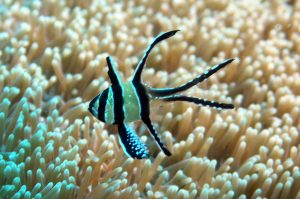This post may contain affiliate links. As an amazon associate I earn from qualifying purchase. Learn more
Building your first saltwater aquarium can sometimes cause you more headaches than joy. Researching what fish can go with each other is not a fun thing to do.
Even worse, making mistakes can cause a lot of money.
To make your journey easier, I recommend choosing peaceful, community, non-aggressive saltwater aquarium fish.
Fish that easily get along with their tankmates, fish that don’t have aggressive eating habits, and most importantly fish that are easy to take care of.
The problem with choosing saltwater fish for your first tank is that, even though they are considered peaceful, you can’t be 100 percent sure of that. Every fish has its character.
To help you with your choice, I did the research and put together a list of non-aggressive saltwater fish that you can use as inspiration.
Some of the fish are great for beginners, some are not.
This is not a complete list, by any means. But it’s a great list to have as a starting point.

Contents
Non-aggressive Saltwater Aquarium Fish
You must be wondering, what is the least aggressive saltwater fish?
Ideally, non-aggressive saltwater aquarium fish won’t eat invertebrates, corals or smaller fish in your tank.
However, saltwater fish behaviors are much more complex than that. In general, you can’t tell if fish is peaceful or not. There are so many factors you need to consider.
Some fish mighty be peaceful if you keep them as singles, but will get aggressive when they are in pairs. Others might compete for the same food source.
The fish on this list are generally peaceful if the other conditions are met.
Without further ado let’s see the list.
1. Convict Tang
If you are a fan of saltwater tangs and looking for a peaceful tang that will get along with your other fish, then the Convict Tang might be the right choice for you.
The Convict Tang is one of the best community saltwater aquarium fish. However, it’s very docile and can often get picked on by other surgeonfish. And that’s why the best practice is to keep them with other peaceful saltwater fish, preferably in 75 gallons tanks or more, with an adequate swimming space.
2. Banggai Cardinalfish
Another non-aggressive saltwater fish on this list is the Banggai Cardinalfish. It is also known as the Kaudern’s Cardinalfish and it is native the area around Banggai Island off Sulawesi.
Growing to around 3 inches, it should be kept in at least 30 gallons tanks.
They are generally peaceful saltwater fish, however, they can be aggressive towards each other. Keep them in pairs, or make sure that you have a larger tank, so the aggression can be spread.
3. Green Chromis
Looking for a great schooling saltwater fish, that is peaceful and easy to care for too?
Well, you might check the Green Chromis.
They are beautiful, active little fish with attractive color patterns. Many aquarists choose them as the first saltwater fish.
Even though they belong in the group of Damselfish, the Green Chromis is a relatively peaceful saltwater fish. They do best in groups of 6 in more. However, they might get slightly aggressive when they get older, and reach breeding age.
4. Anthias
One of the best schooling saltwater aquarium fish, that also have a peaceful character is the Ignitus Anthias.
These colorful saltwater fish reach sizes up to 3 inches and should be kept in at least 70 gallons tanks.
If you want to see their natural behavior and enjoy their vibrant colors the best way is to keep them in groups.
Conclusion
We can both agree that carefully planning on your stocking is a vital part of building a successful saltwater aquarium.
Beginner aquarists often make mistakes. And that’s ok. It’s part of the hobby.
However, choosing a non-aggressive, peaceful saltwater aquarium fish for your first tank is the best way to have success in the long run.
Now, I’d like to hear from you.
What was your first saltwater fish?
Featured Image: Jens Petersen CC BY-SA 3.0